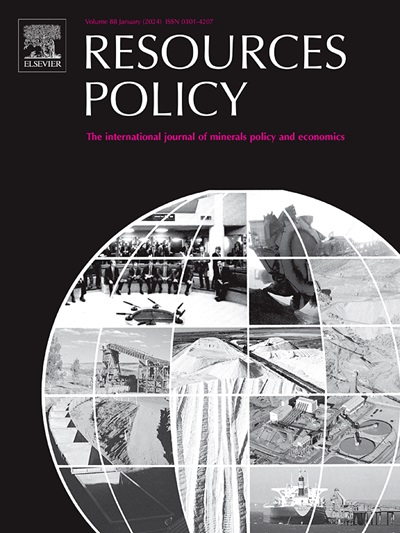Strategic potential assessment of lanthanum and scandium through geochemical-lithological analysis with unsupervised machine learning in southern Ecuador
IF 10.2
2区 经济学
0 ENVIRONMENTAL STUDIES
引用次数: 0
Abstract
The preliminary identification of areas with strategic geochemical potential poses a major challenge in mineral exploration when only surface-level and unclassified data are available. This study aimed to integrate geostatistical techniques with unsupervised machine learning algorithms to classify zones of high, medium, and low potential for lanthanum (La) and scandium (Sc) in southern Ecuador. A database comprising 3998 geochemical samples was used, with concentrations estimated via Ordinary Kriging (OK), employing variogram structures tailored to each element. The K-means, Gaussian Mixture Models (GMM), Mini-Batch K-means (MBKM), and Spectral Clustering (SC) algorithms were applied to the interpolated values to achieve automated spatial segmentation. Validation against a traditional percentile-based classification yielded high accuracy, with SC (accuracy = 0.898) and KM (0.860) performing best for La, and GMM (0.899) for Sc. Additionally, total metal contents per zone were estimated, reaching up to 725.10 t of La (average grade: 11.98 mg/kg) and 103.23 t of Sc (average grade: 2.08 mg/kg) in medium-potential zones according to GMM and SC, respectively. Strong lithological associations were identified, particularly highlighting the JUB unit as key for scandium occurrence. Overall, the results confirm that the combination of kriging and unsupervised clustering enables effective classification of mineralogical domains with high spatial coherence, providing a robust tool for prioritizing target areas in early exploration stages.
在厄瓜多尔南部,通过无监督机器学习的地球化学-岩性分析对镧和钪的战略潜力进行评估
在只有地表和未分类数据的情况下,初步确定具有战略地球化学潜力的地区对矿物勘探构成重大挑战。本研究旨在将地质统计学技术与无监督机器学习算法相结合,对厄瓜多尔南部镧(La)和钪(Sc)的高、中、低潜力区进行分类。使用了包含3998个地球化学样品的数据库,通过普通克里格法(OK)估计浓度,采用针对每种元素定制的变异图结构。采用K-means、高斯混合模型(GMM)、Mini-Batch K-means (MBKM)和谱聚类(SC)算法对插值值进行自动空间分割。采用传统的百分位分类方法进行验证,获得了较高的准确性,其中SC(精度= 0.898)和KM(精度= 0.860)对La的检测效果最好,而GMM(0.899)对SC的检测效果最好。此外,根据GMM和SC估算,中电位区各区域的总金属含量分别高达725.10 t La(平均品位:11.98 mg/kg)和103.23 t SC(平均品位:2.08 mg/kg)。发现了强烈的岩性关联,特别突出了JUB单元是钪赋存的关键。总的来说,结果证实,克里格和无监督聚类的结合可以有效地分类具有高空间相干性的矿物域,为在早期勘探阶段优先考虑目标区域提供了一个强大的工具。
本文章由计算机程序翻译,如有差异,请以英文原文为准。
求助全文
约1分钟内获得全文
求助全文
来源期刊

Resources Policy
ENVIRONMENTAL STUDIES-
CiteScore
13.40
自引率
23.50%
发文量
602
审稿时长
69 days
期刊介绍:
Resources Policy is an international journal focused on the economics and policy aspects of mineral and fossil fuel extraction, production, and utilization. It targets individuals in academia, government, and industry. The journal seeks original research submissions analyzing public policy, economics, social science, geography, and finance in the fields of mining, non-fuel minerals, energy minerals, fossil fuels, and metals. Mineral economics topics covered include mineral market analysis, price analysis, project evaluation, mining and sustainable development, mineral resource rents, resource curse, mineral wealth and corruption, mineral taxation and regulation, strategic minerals and their supply, and the impact of mineral development on local communities and indigenous populations. The journal specifically excludes papers with agriculture, forestry, or fisheries as their primary focus.
 求助内容:
求助内容: 应助结果提醒方式:
应助结果提醒方式:


